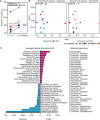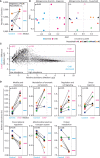Patients With Common Variable Immunodeficiency (CVID) Show Higher Gut Bacterial Diversity and Levels of Low-Abundance Genes Than the Healthy Housemates
- PMID: 34054845
- PMCID: PMC8163231
- DOI: 10.3389/fimmu.2021.671239
Patients With Common Variable Immunodeficiency (CVID) Show Higher Gut Bacterial Diversity and Levels of Low-Abundance Genes Than the Healthy Housemates
Abstract
Common variable immunodeficiency (CVID) is a clinically and genetically heterogeneous disorder with inadequate antibody responses and low levels of immunoglobulins including IgA that is involved in the maintenance of the intestinal homeostasis. In this study, we analyzed the taxonomical and functional metagenome of the fecal microbiota and stool metabolome in a cohort of six CVID patients without gastroenterological symptomatology and their healthy housemates. The fecal microbiome of CVID patients contained higher numbers of bacterial species and altered abundance of thirty-four species. Hungatella hathewayi was frequent in CVID microbiome and absent in controls. Moreover, the CVID metagenome was enriched for low-abundance genes likely encoding nonessential functions, such as bacterial motility and metabolism of aromatic compounds. Metabolomics revealed dysregulation in several metabolic pathways, mostly associated with decreased levels of adenosine in CVID patients. Identified features have been consistently associated with CVID diagnosis across the patients with various immunological characteristics, length of treatment, and age. Taken together, this initial study revealed expansion of bacterial diversity in the host immunodeficient conditions and suggested several bacterial species and metabolites, which have potential to be diagnostic and/or prognostic CVID markers in the future.
Keywords: CVID; Hungatella hathewayi; common variable immunodeficiency; metabolome; metagenome; microbiome.
Copyright © 2021 Bosák, Lexa, Fiedorová, Gadara, Micenková, Spacil, Litzman, Freiberger and Šmajs.
Conflict of interest statement
The authors declare that the research was conducted in the absence of any commercial or financial relationships that could be construed as a potential conflict of interest.
Figures




Similar articles
-
Fecal Immunoglobulin Levels as a Modifier of the Gut Microbiome in Patients with Common Variable Immunodeficiency.J Clin Immunol. 2023 Aug;43(6):1208-1220. doi: 10.1007/s10875-023-01469-9. Epub 2023 Mar 24. J Clin Immunol. 2023. PMID: 36961604 Free PMC article.
-
Oropharyngeal microbial ecosystem perturbations influence the risk for acute respiratory infections in common variable immunodeficiency.Front Immunol. 2024 May 30;15:1371118. doi: 10.3389/fimmu.2024.1371118. eCollection 2024. Front Immunol. 2024. PMID: 38873612 Free PMC article.
-
Bacterial but Not Fungal Gut Microbiota Alterations Are Associated With Common Variable Immunodeficiency (CVID) Phenotype.Front Immunol. 2019 Aug 13;10:1914. doi: 10.3389/fimmu.2019.01914. eCollection 2019. Front Immunol. 2019. PMID: 31456808 Free PMC article.
-
Microbial Dysbiosis in Common Variable Immune Deficiencies: Evidence, Causes, and Consequences.Trends Immunol. 2017 Mar;38(3):206-216. doi: 10.1016/j.it.2016.11.008. Epub 2016 Dec 22. Trends Immunol. 2017. PMID: 28017520 Review.
-
Gut Microbiome and Common Variable Immunodeficiency: Few Certainties and Many Outstanding Questions.Front Immunol. 2021 Aug 2;12:712915. doi: 10.3389/fimmu.2021.712915. eCollection 2021. Front Immunol. 2021. PMID: 34408753 Free PMC article. Review.
Cited by
-
Relation between dysbiosis and inborn errors of immunity.World J Methodol. 2024 Dec 20;14(4):96380. doi: 10.5662/wjm.v14.i4.96380. eCollection 2024 Dec 20. World J Methodol. 2024. PMID: 39712559 Free PMC article. Review.
-
Mendelian randomization analysis reveals causal relationships between gut microbiome and optic neuritis.Hum Genet. 2023 Aug;142(8):1139-1148. doi: 10.1007/s00439-022-02514-0. Epub 2022 Dec 28. Hum Genet. 2023. PMID: 36576600
-
Possible Role of Cytomegalovirus in Gastric Cancer Development and Recurrent Macrolide-Resistant Campylobacter jejuni Infection in Common Variable Immunodeficiency: A Case Report and Literature Discussion.Microorganisms. 2024 May 27;12(6):1078. doi: 10.3390/microorganisms12061078. Microorganisms. 2024. PMID: 38930460 Free PMC article. Review.
-
Is there a role for microbiome-based approach in common variable immunodeficiency?Clin Exp Med. 2023 Oct;23(6):1981-1998. doi: 10.1007/s10238-023-01006-3. Epub 2023 Feb 3. Clin Exp Med. 2023. PMID: 36737487 Free PMC article. Review.
-
Disturbed lipid profile in common variable immunodeficiency - a pathogenic loop of inflammation and metabolic disturbances.Front Immunol. 2023 Jul 20;14:1199727. doi: 10.3389/fimmu.2023.1199727. eCollection 2023. Front Immunol. 2023. PMID: 37545531 Free PMC article. Review.
References
Publication types
MeSH terms
Substances
Supplementary concepts
LinkOut - more resources
Full Text Sources
Other Literature Sources
Miscellaneous

